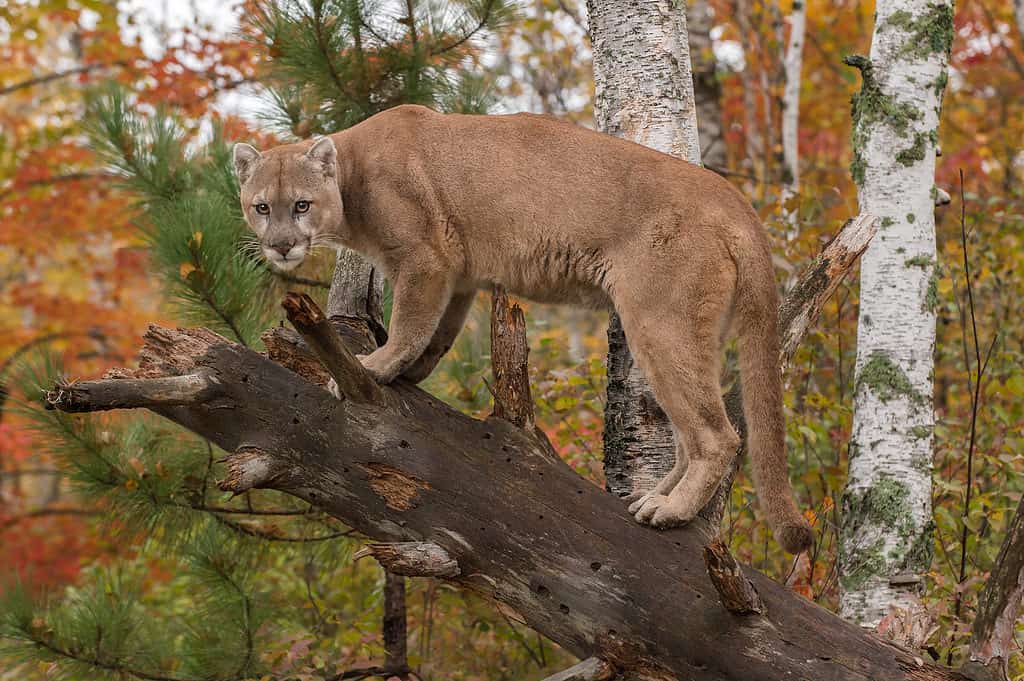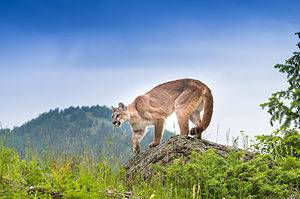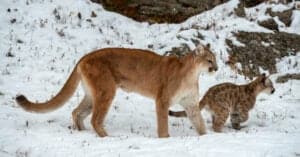The mountain lion, also known as the cougar or puma, is one of the most impressive big cats in North America. It is the second largest cat on the continent, with only the jaguar being bigger.
Even though virtually all mountain lions are large, some are bigger than others. When people hunt large game, the size of the specific animal often matters because a huge animal is a more impressive catch.
Mountain lions are particularly impressive catches because of their ability to run quickly. Read on to learn more about the largest mountain lion ever caught!
Background Information on the Mountain Lion

Mountain lions usually prefer habitats where they have dense cover and undergrowth.
©Geoffrey Kuchera/Shutterstock.com
Although mountain lions are predators, they are not as dangerous to humans as many would think. Learn about these big cats before forming an opinion about them.
Range and Habitat
Mountain lions were originally plentiful in North America and South America. However, their range has been greatly reduced. Now, these cats are only seen in 12 states throughout the Western United States, as well as the Florida Everglades, Alberta, and British Columbia.
Mountain lions usually prefer habitats where they have dense cover and undergrowth. If they perceive a threat, they will remove themselves from the area. Typically, they can live in a variety of habitats. They have been found both at sea level and on mountain peaks. These cats also live in woodlands, hillsides, humid forests, and deserts.
Mountain lions can live anywhere that they find prey and shelter. They have naturally low population densities and need large spacious areas in order to thrive. These wildcats are relatively solitary animals, except during mating season and when parenting their cubs. Males usually have a range of about 100 square miles, and females have a range of 20 to 60 square miles.
Diet
Mountain lions are opportunistic hunters. Typically, they will hunt by themselves between dusk and dawn. They sneak up on their prey from behind. They will often lie waiting for prey or silently stalk it before pouncing and lethally biting the spinal cord.
Surprisingly, mountain lions have a poor sense of smell. However, they are still able to be adept hunters because of their excellent hearing and vision. They are also able to pounce from very far away because of their powerful hind legs. Mountain lions can typically jump 40 to 45 feet in a single motion!
The meal of choice for a mountain lion is usually deer. The average mountain lion kills one deer every week. However, they will also eat porcupines, elk, rodents, feral hogs, raccoons, and coyotes. These cats are strict carnivores and will only eat vegetation in rare instances.
In some cases, a mountain lion will drag a carcass to a different area and cover it up with natural materials to hide it from other animals. They come back to the spot and feed on the same carcass over the course of days.
Appearance and Size
Though mountain lion cubs have camouflaging rings and spots around their tails, adult mountain lions have more solid tan coats. Males and females look fairly alike, although male lions are about 30 to 40 percent larger than their female counterparts.
Sizes can vary, especially between geographic ranges. However, a typical adult female will be between 80 and 130 pounds, and a typical male will be 110 to 180 pounds. There are mountain lions that exceed 200 pounds in weight, but this is fairly rare.
In terms of length, adult males are typically between 6 and 8 feet long from the tip of the tail to the nose, and females are 5 to 7 feet long.
The Largest Mountain Lion Ever Caught
The largest mountain lion ever caught is said to have weighed 276 pounds, although where and when this cat was caught is unknown.
The largest mountain lion catch recorded by the Boone and Crockett Club had a skull measurement of 16 4/16; this cat was hunted and killed in 1979 in British Columbia. Douglas E. Schuk is the one who shot this animal, with the help of his pack of hunting dogs.
Schuk could tell from the noises the dogs were making and the hissing coming from the cat in response that they had the mountain lion cornered. Knowing that these big cats are capable of killing hounds with one swipe of their paws, he shot the mountain lion with his .308 rifle before the cat had a chance to injure his dogs.
Charles M. Travers is the current owner of the cougar‘s skull. When it was officially measured, it was in his possession. Boone and Crockett confirmed this cat to be the new record-breaking cougar.
Where was the Site of the Largest Mountain Lion Ever Caught Located on a map?
The specific location of the site is unknown, but the largest mountain lion ever caught was in the Canadian province of British Columbia. The westernmost province of Canada, British Columbia borders the United States to the south and the Pacific Ocean to the west. Its southernmost city of Vancouver is just across the southern border from the city of Seatle, Washington, U.S.
Mountain Lions and Humans

Many are paranoid about mountain lions attacking humans. However, this rarely happens.
©Scott E Read/Shutterstock.com
Bounty hunting of mountain lions, bears, and wolves has been an issue in North America since the 1600s. By the 1900s, these animals had been hunted and killed in very high numbers. Although people’s initial rationale behind hunting them had been that they had a negative effect on game populations, killing them also had negative effects. The loss of predator populations threw the ecosystems off balance. There was now an overpopulation of herbivores, such as deer. This led to increased erosion, overgrazing, and an overall decline in the health of these ecosystems.
Efforts to restore environmental health began in the 1960s, curbing the hunting of these predators. However, mountain lion populations and ranges still aren’t what they once were.
People are often paranoid about mountain lion populations because they are afraid that these cats will go after their livestock. However, in reality, as long as the deer populations remain high, mountain lions will generally leave livestock alone.
Additionally, many are paranoid about mountain lions attacking humans. However, this rarely happens. Even when it does, it’s usually an indirect result of what humans have done to these cats’ habitats. Humans have encroached upon their territories, limiting their range. Dominant mountain lion males have pushed juveniles into marginal habitats, and these juveniles become hunger crazed. In the rare event that a mountain lion attacks a human, it is almost always one of these hungry juveniles.
If people would respect the habitats of these big cats, humans and mountain lions would be more likely to peacefully coexist.
The photo featured at the top of this post is © Kwadrat/Shutterstock.com
Thank you for reading! Have some feedback for us? Contact the AZ Animals editorial team.






